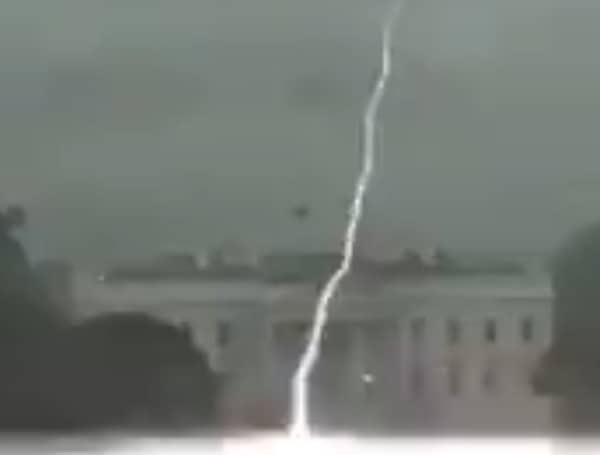Floridians, who are residents of the “lightning capital” of the United States, perhaps should be very interested in the tragic story of three people killed last week by a lightning strike in Washington, D.C.
The problem, though, is that at least one report of the fatal incident, filed by the Reuters news service, went exactly where you might think the liberal media would immediately go: It was really climate change that killed those poor souls near the White House.
Reuters called that sorrowful event a “climate warning.”
But ClimateDepot.com, a conservative group that chronicles the climate-crisis movement, noted some problems for Reuters and others who seized on this tragedy as evidence of their narrative.
As Reuters began its account of the strike, “Scientists say that climate change is increasing the likelihood of lightning strikes across the United States, after lightning struck at a square near the White House, leaving three people dead and one other in critical condition.”
“The hot, humid conditions in Washington, D.C., on Thursday were primed for electricity. Air temperatures topped out at 94 degrees Fahrenheit (34 degrees Celsius) – or 5F (3C) higher than the 30-year normal maximum temperature for Aug. 4, according to the National Weather Service.”
“More heat can draw more moisture into the atmosphere, while also encouraging rapid updraft – two key factors for charged particles, which lead to lightning,” Reuters continued. “A key study released in 2014 in the journal Science warned that the number of lightning strikes could increase by 50% in this century in the United States, with each 1 C (1.8 F) of warming translating into a 12% rise in the number of lightning strikes.”
In the news: Rep. Steube Seeks To Save U.S. Farmland From Hostile Foreign Interests
Reuters added, “Fast-warming Alaska has seen a 17% rise in lightning activity since the cooler 1980s. And in typically dry California, a siege of some 14,000 lightning strikes during August 2020 sparked some of the state’s biggest wildfires on record.”
“Beyond the United States, there is evidence that lightning strikes are also shooting up in India and Brazil.”
Yet ClimateDepot.com saw a few flaws in Reuters’ theory.
The first was that the number of lightning-related deaths and injuries has dropped steadily and dramatically between 1995 and 2020 – a period when Earth was reportedly heating up.
There were 85 deaths and 433 injuries from lightning in 1995. By 2020, those numbers were down to 17 and 53, respectively, according to research by the data analysts at Statistia.com that Climate Depot cited.
Climate Depot also highlighted a tweet by University of Colorado environmental studies professor Roger Pielke Jr.
Pielke pointed out that the drop in lightning-related fatalities are even more significant if expand the time frame.
On Twitter, he posted a chart by the website OurWorldinData.org.
The research showed that the annual death rate from lightning strikes in the U.S. peaked at 6.32 per 1 million people in 1901.
By 2015, the last year the website included in its chart, it was 0.08 per million – a plunge of 98.8 percent.
Climate Depot’s final inconvenient fact for Reuters was a 2018 article by the Daily Mail.
It said scientists believed lightning strikes would actually drop in the future, perhaps as much as 15 percent – because of climate change.
The theory is that more global warming would reduce the formation of ice crystals in the sky that during storms can hold electrical charges and produce lightning.
As one of the authors of the study, Professor Ruth Doherty of the University of Edinburgh’s School of Geosciences, said: “This research expands our current knowledge of climate change impacts on lightning and suggests that in a warmer world, the incidence of lightning is likely to decrease.”
“Which is it?!” Climate Depot asked.
“Predict both outcomes & you are never wrong! Climate studies predict LESS & MORE lightning strikes.”
As for Florida, the National Lightning Data Network in January reported that the Sunshine State recorded an average of 223 lightning “events” per square mile during 2021.
A lightning event includes both intracloud “pulses” as well as cloud-to-ground strikes.
Florida had only one-third the number of lightning events as Texas in 2021, which was good for second place in that category. Where Florida led the nation was in “lightning density,” which measures the number of events by a square area, which in this case was miles.
Louisiana came in second in the density category with 211 per square mile.
Visit Tampafp.com for Politics, Tampa Area Local News, Sports, and National Headlines. Support journalism by clicking here to our GiveSendGo or sign up for our free newsletter by clicking here.
Android Users, Click Here To Download The Free Press App And Never Miss A Story. Follow Us On Facebook Here Or Twitter Here.
The views and opinions expressed in this political commentary are those of the author and do not necessarily reflect the opinions of The Free Press.
Copyright 2022 The Free Press, LLC, tampafp.com. All rights reserved. This material may not be published, broadcast, rewritten, or redistributed.



